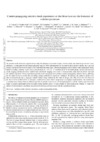Please use this identifier to cite or link to this item:
https://accedacris.ulpgc.es/handle/10553/35732
| Title: | Counter-propagating radiative shock experiments on the Orion laser and the formation of radiative precursors | Authors: | Clayson, T. Suzuki-Vidal, F. Lebedev, S. V. Swadling, G.F. Stehlé, C. Burdiak, G. Foster, J.M. Skidmore, J. Graham, P. Gumbrell, E.T. Patankar, S. Spindloe, C. Chaulagain, U. Kozlova, M. Larour, J. Singh, R. L. Rodriguez, R. Gil, J. M. Espinosa Vivas, Guadalupe Velarde, P. Danson, C. |
UNESCO Clasification: | 22 Física | Keywords: | Radiative shock Radiative precursor Counter propagating shocks |
Issue Date: | 2017 | Journal: | High Energy Density Physics | Abstract: | We present results from new experiments to study the dynamics of radiative shocks, reverse shocks and radiative precursors. Laser ablation of a solid piston by the Orion high-power laser at AWE Aldermaston UK was used to drive radiative shocks into a gas cell initially pressurised between 0.1 and 1.0 bar with different noble gases. Shocks propagated at 80 +/- 10 km/s and experienced strong radiative cooling resulting in post-shock compressions of x25 +/- 2. A combination of X-ray backlighting, optical self-emission streak imaging and interferometry (multi-frame and streak imaging) were used to simultaneously study both the shock front and the radiative precursor. These experiments present a new configuration to produce counter-propagating radiative shocks, allowing for the study of reverse shocks and providing a unique platform for numerical validation. In addition, the radiative shocks were able to expand freely into a large gas volume without being confined by the walls of the gas cell. This allows for 3-D effects of the shocks to be studied which, in principle, could lead to a more direct comparison to astrophysical phenomena. By maintaining a constant mass density between different gas fills the shocks evolved with similar hydrodynamics but the radiative precursor was found to extend significantly further in higher atomic number gases (similar to 4 times further in xenon than neon). Finally, 1-D and 2-D radiative-hydrodynamic simulations are presented showing good agreement with the experimental data. | URI: | https://accedacris.ulpgc.es/handle/10553/35732 | ISSN: | 1574-1818 | DOI: | 10.1016/j.hedp.2017.03.002 | Source: | High Energy Density Physics [ISSN 1574-1818], v. 23, p. 60-72 |
| Appears in Collections: | Artículos |
SCOPUSTM
Citations
10
checked on Jun 8, 2025
WEB OF SCIENCETM
Citations
10
checked on Jun 8, 2025
Page view(s)
95
checked on Jan 27, 2024
Download(s)
87
checked on Jan 27, 2024
Google ScholarTM
Check
Altmetric
Share
Export metadata
Items in accedaCRIS are protected by copyright, with all rights reserved, unless otherwise indicated.
